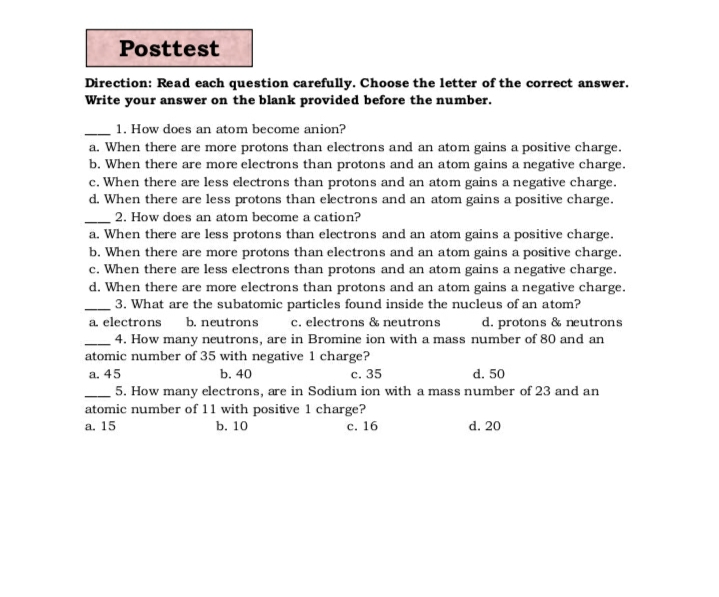2. How does an atom become a cation? a. When there are less protons than electrons and an atom gains a positive charge. b. When there are more protons than electrons and an atom gains a positive charge. c. When there are less electrons than protons and an atom gains a negative charge. d. When there are more electrons than protons and an atom gains a negative charge. 3. What are the subatomic particles found inside the nucleus of an atom? c. electrons & neutrons 4. How many neutrons, are in Bromine ion with a mass number of 80 and an a electrons b. neutrons d. protons & neutrons atomic number of 35 with negative 1 charge? d. 50 c. 35 5. How many electrons, are in Sodium ion with a mass number of 23 and an a. 45 b. 40 atomic number of 11 with positive 1 charge? a. 15 b. 10 с. 16 d. 20
2. How does an atom become a cation? a. When there are less protons than electrons and an atom gains a positive charge. b. When there are more protons than electrons and an atom gains a positive charge. c. When there are less electrons than protons and an atom gains a negative charge. d. When there are more electrons than protons and an atom gains a negative charge. 3. What are the subatomic particles found inside the nucleus of an atom? c. electrons & neutrons 4. How many neutrons, are in Bromine ion with a mass number of 80 and an a electrons b. neutrons d. protons & neutrons atomic number of 35 with negative 1 charge? d. 50 c. 35 5. How many electrons, are in Sodium ion with a mass number of 23 and an a. 45 b. 40 atomic number of 11 with positive 1 charge? a. 15 b. 10 с. 16 d. 20
Introductory Chemistry: An Active Learning Approach
6th Edition
ISBN:9781305079250
Author:Mark S. Cracolice, Ed Peters
Publisher:Mark S. Cracolice, Ed Peters
Chapter5: Atomic Theory : The Nuclear Model Of The Atom
Section: Chapter Questions
Problem 59E
Related questions
Question
100%
answer 2,3,4,5

Transcribed Image Text:Posttest
Direction: Read each question carefully. Choose the letter of the correct answer.
Write your answer on the blank provided before the number.
1. How does an atom become anion?
a. When there are more protons than electrons and an atom gains a positive charge.
b. When there are more electrons than protons and an atom gains a negative charge.
c. When there are less electrons than protons and an atom gains a negative charge.
d. When there are less protons than electrons and an atom gains a positive charge.
2. How does an atom become a cation?
a. When there are less protons than electrons and an atom gains a positive charge.
b. When there are more protons than electrons and an atom gains a positive charge.
c. When there are less electrons than protons and an atom gains a negative charge.
d. When there are more electrons than protons and an atom gains a negative charge.
3. What are the subatomic particles found inside the nucleus of an atom?
a. electrons
b. neutrons
c. electrons & neutrons
d. protons & neutrons
4. How many neutrons, are in Bromine ion with a mass number of 80 and an
atomic number of 35 with negative 1 charge?
a. 45
b. 40
с. 35
d. 50
5. How many electrons, are in Sodium ion with a mass number of 23 and an
atomic number of 11 with positive 1 charge?
b. 10
a. 15
с. 16
d. 20
Expert Solution
This question has been solved!
Explore an expertly crafted, step-by-step solution for a thorough understanding of key concepts.
Step by step
Solved in 5 steps with 5 images

Knowledge Booster
Learn more about
Need a deep-dive on the concept behind this application? Look no further. Learn more about this topic, chemistry and related others by exploring similar questions and additional content below.Recommended textbooks for you

Introductory Chemistry: An Active Learning Approa…
Chemistry
ISBN:
9781305079250
Author:
Mark S. Cracolice, Ed Peters
Publisher:
Cengage Learning

World of Chemistry, 3rd edition
Chemistry
ISBN:
9781133109655
Author:
Steven S. Zumdahl, Susan L. Zumdahl, Donald J. DeCoste
Publisher:
Brooks / Cole / Cengage Learning

Introductory Chemistry: A Foundation
Chemistry
ISBN:
9781337399425
Author:
Steven S. Zumdahl, Donald J. DeCoste
Publisher:
Cengage Learning

Introductory Chemistry: An Active Learning Approa…
Chemistry
ISBN:
9781305079250
Author:
Mark S. Cracolice, Ed Peters
Publisher:
Cengage Learning

World of Chemistry, 3rd edition
Chemistry
ISBN:
9781133109655
Author:
Steven S. Zumdahl, Susan L. Zumdahl, Donald J. DeCoste
Publisher:
Brooks / Cole / Cengage Learning

Introductory Chemistry: A Foundation
Chemistry
ISBN:
9781337399425
Author:
Steven S. Zumdahl, Donald J. DeCoste
Publisher:
Cengage Learning


Chemistry for Today: General, Organic, and Bioche…
Chemistry
ISBN:
9781305960060
Author:
Spencer L. Seager, Michael R. Slabaugh, Maren S. Hansen
Publisher:
Cengage Learning
